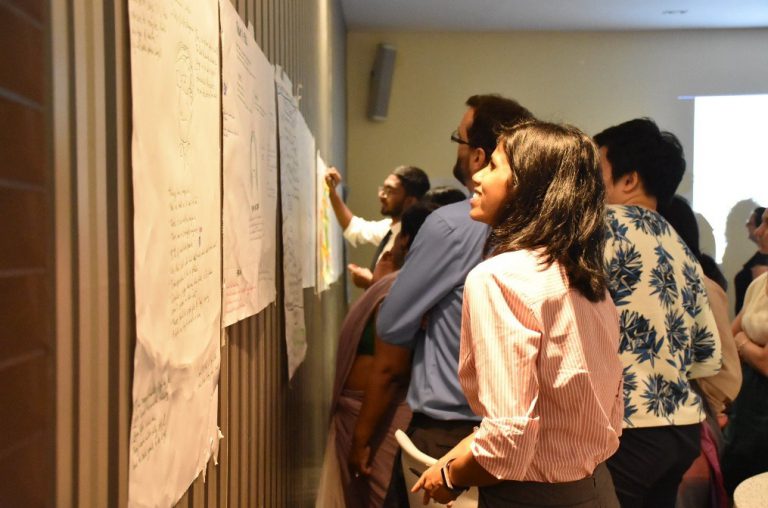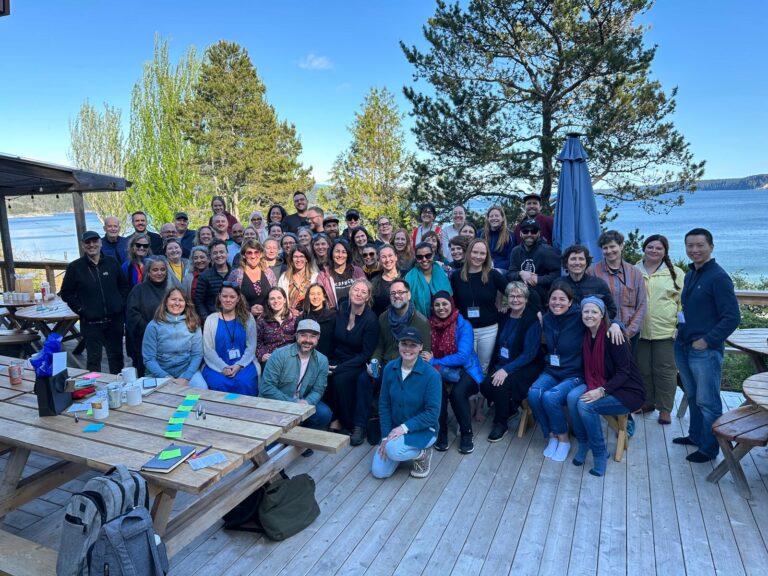
16 October 2020
Embracing ambiguity: Brent Wellsch joins the Urban Matters team
Urban Matters recently welcomed Brent Wellsch to our team as our Solutions Lab Lead. A systemic designer and strategist, Brent comes to UM from the Government of Alberta, where he helped to establish the Alberta CoLab, one of Canada’s first public-sector innovation labs. He’s currently part of a United Nations social-innovation project exploring approaches to the plastic waste crisis in Southeast Asia.
At UM, Brent is excited to learn from and draw on his colleagues’ breadth of talent and experience, and to bring his considerable innovation, facilitation and convening skills to our efforts to find sustainable solutions to complex problems — both to meet the challenges of the present moment and to build robust and resilient responses to the challenges of an uncertain future.
A native of Saskatchewan, Brent now lives in Edmonton with his family. He’s delighted to be at the forefront of expanding UM’s presence in Alberta and the Prairie provinces, and is looking forward to helping to build UM’s capacity as a thriving member of Canada’s social innovation community.
We connected with Brent talk about his social innovation, the radical potential of ambiguity, and what excites him about Urban Matters’ approach.
You are joining Urban Matters as our Solutions Lab Lead. What does this mean? What will you be doing?
A solutions lab — or a social-innovation lab — is a space, although not necessarily a physical space, where people come together to approach real, complex issues in a new way. And my role is to serve as a guide by helping people navigate the challenges of journeying through that space. I do that with the help of a variety of methodologies, for example, systemic design and strategic foresight.
As human beings, particularly human beings in Western society, we are wired to jump to solutions without really, thoroughly examining the problem space. A lab approach turns the problem on its head; it lets people zoom out and see all the parts of the problem, how they connect to each other, and how those connections manifest into particular behaviours. If we can see and adhere to different understandings of the problem, we open up new pathways to solutions.
Another important methodology involves bringing in and embracing the human qualities of complexity. In our calculus of a problem, we always think about feasibility and viability, but we rarely think about desirability: what do people actually want? How will this particular approach or policy decision actually be experienced by the end user? A lab approach, crucially, bridges the gap between technical expertise and the powerful intuitive, participatory knowledge and evidence we need to bring to the problem space.
What are some examples?
At the Alberta CoLab, we used a lab approach to shed new light on all sorts of complex challenges, like early childhood education, healthcare reform, management, and energy transition, which was eventually our team’s main focus: as we acknowledge, increasingly that climate change is real and that we need to adapt, and more and more we are seeing technical breakthroughs on the energy front, we need to ask how do we steward that adoption process in our society, while at the same time not giving up on the things that have made us successful in the past? A lab approach can be incredibly useful for that as it embraces integrative possibility.
Disaster relief and recovery is an example that always comes to mind for me as it was one of the best experiences of a problem “reframe” that I have been a part of. A few years ago, I was working with a team that was exploring the complex relationship space between disaster response and disaster recovery, the key components of each, and the key responsibilities of “system actors” in this transition. Initially, everyone on the team was focussing attention on recovery and what that meant for their work. However, through our time together the team began to shift their thinking from a “recovery” to a “resilience” focus. They recognized that communities may continue to face more and more disaster related events due to changing climate conditions, and as such the work shouldn’t be overly focussed on a reactive oriented approach around recovery. They knew they had to embrace a more holistic approach around building communities up to be resilient. This may seem subtle but is a powerful reframe as it unlocks a whole new path for solutioning around the problem space.
It’s not a magic process. It runs a nonlinear course from problem framing to problem-solving to prototyping solutions to learn what actually works, and then scaling the solutions. That’s a lot of work. It takes a lot of heavy thinking, and, often, a lot of tenacity and dedication — not to mention political capital, public and private buy-in, resources, and more. Sometimes you have these things, and sometimes you don’t. That said, the process is scalable: it can be adapted to meet will and intent as long as its always known that addressing complexity cannot be met with linear thinking and single-point solutions.

Your work has been described as helping clients to “embrace ambiguity” in order to innovate through complex challenges. What does it mean to embrace ambiguity? And why is it so necessary?
There’s an acronym — VUCA — used in military and more recently management circles: it stands for volatile, uncertain, complex, ambiguous. Our governments live in an environment of VUCA. But, too often, they are ill-equipped to navigate that environment.
We live in a time of rapid global change. COVID-19 is a very a recent example of a phenomenon that began as a weak signal in one part of the world and amplified into a global pandemic that has left governments struggling to come up with a response. Shifting energy systems and energy transition as I mentioned previously, as a complex problem space is also an example. This obviously, has a lot of resonance here in Alberta, where so much of our social and economic DNA has been based upon the bedrock of a hydrocarbon-based energy economy, and deeply engrained assumptions about the stability of this system. What do you do when the external environment begins to change? How do you innovate into adjacent possibilities? What do you do when your assumptions begin to be fundamentally challenged?
That’s where it’s important, for governments especially, to embrace ambiguity. It allows them to begin to interrogate those bedrock, ingrained assumptions before they start to crumble and they are forced into a reactive mode, where they’re always playing catch-up and doing the best they can (hello, COVID-19). Governments especially need to face ambiguity so that they can challenge their assumptions and come up with proactive, robust contingency strategies, no matter what happens.
How does that resonate with your role at Urban Matters?
It’s actually one of the many reasons I’m excited about working here. [UM president] Ken Gauthier has a “three horizon” vision that is really focused on building solutions for navigating that ambiguous, unknown future. Of course, we can bring a lot of expertise to known quantities and problems, but I’m excited to be positioned to work on the contingency issues, on the problems that challenge our bedrock assumptions, to help governments, communities and other actors build those robust, resilient approaches.
What else is exciting about working at UM?
Being in government was great work, and is an experience that I am truly indebted to. However, our “clients” were mostly internal working groups requiring assistance on internally led projects. It was difficult at times to get out and talk to the people who were actually affected by the decisions we made. At Urban Matters, the team is thoroughly embedded in community. It’s like taking off handcuffs — the world, within reason, is my oyster in terms of taking the whole ethic of what I was doing in government and applying that on the ground with and within communities, at Ground Zero for the complex issues that we face.
I’m excited to work with the broad range of skills sets and talents of people on the team. It’s comforting to know that no matter what situation I find myself and I’ll be able to reach out and ask for support as needed. It’s a really supportive, collaborative environment.
And the team understands social innovation. They get the value of it. I’m excited that Urban Matters as an organization is looking to raise its bench strength in the field, putting skin in the game by bringing in skill sets like mine to accelerate their capacity to help communities adapt and change.
 You are one of the first UM team members based in Alberta.
You are one of the first UM team members based in Alberta.
Yes! I’m working a couple of days a week out of the Urban Systems office here in Edmonton. A core part of my job is being an Urban Matters ambassador to Alberta and, I hope, the Prairie provinces. I’m originally from Saskatchewan, and my mission is to begin to do some work there as well, to begin to build trust relationships with these communities. The social innovation community in Canada has really exploded in the last seven or eight years. I’m really happy to be in a position where I can help to carve out a collaborative niche for Urban Matters within that network, to help make us a permanent fixture of that national landscape.




